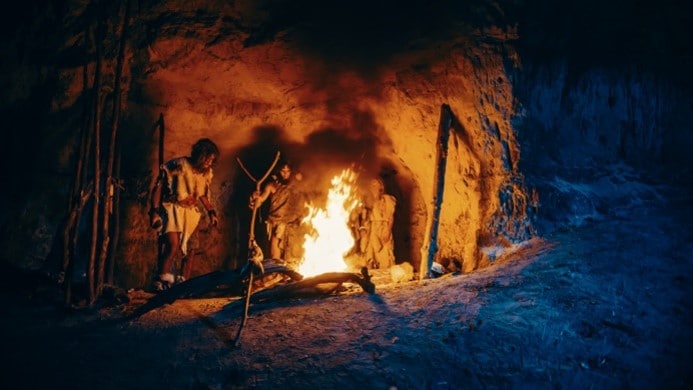Smoke extraction 40,000 years ago - why our ancestors did not suffocate during the Vogelherd cave fire

When the first people laboriously lit the first fires with the help of flints and tinder to warm themselves in or in front of the cave in the evening and to grill their meat, fire protection had not yet been invented.
Presumably, there were also no real smoke removal concepts using CFD flow simulation yet, but the cavers relied on natural conditions.
But I'm pretty sure that sitting in the smoke was as unpleasant back then as it is today.
In a previous blog article, we already looked at the scanned data of the cave and surrounding area in terms of rain: (https://www.merkle-partner.de/de/starkregen-am-vogelherd-welterbe/)
Now let's take a look at how the natural smoke extraction system of Vogelherd Cave works.
For those who are not familiar with the local conditions, it goes here to the scan data from the State Office for the Preservation of Monuments in the Regional Council of Stuttgart indicated.
You can virtually walk through the cave there. You can see a screenshot of the view of the Vogelherd cave from the outside in Figure 2.
The cave has a total of 3 openings, the two entrances (right and left in Figure 2) and a small channel.
In the video it can be clearly seen that smoke escapes only at the high left entrance, while the right passage remains largely smoke-free. Fresh air flows essentially through the right passage and the small channel, while a warming smoke cushion forms under the ceiling of the main cave and the smoke escapes selectively at one point. We are practically looking at one of the first natural central heating systems of human dwellings.
Warm and smoke-free: perhaps this was the reason that man had time and muse for the production of the first works of art here of all places? After all, experts estimate the carving time for the creation of the Lion Man at about 300 h.
Nowadays we no longer have to rely on nature to create spaces, we can design our buildings, be they underground garages, hotel halls and congress centers, to be reasonably ventilated, air-conditioned and relatively safe in case of fire.
We are happy to help you with this. Our methods using flow simulation may not be 40,000 years old, but they have been tested on caves at least as old. ????
Contact me. I will show you in a non-binding conversation how you can benefit from our unique, almost 40 years* old know-how.
One more request: share the blog article so that more people can come to the archaeopark to see how humans used to live.
A unique, life-size mammoth is another must-see attraction.
You are helping the relatively small town of Niederstotzingen with the very costly task of preserving an extraordinary UNESCO World Heritage Site.
I look forward to welcoming you to the Archaeopark in the near future.
Your Stefan Merkle

* I have rounded the 40 years generously. It is only 31 years, but the 40 just fits better for the article.
PS: Here you can find the address:
Visit the Vogelherd Cave in the UNESCO World Heritage Site "Caves and Ice Age Art of the Swabian Alb".
Archaeopark Vogelherd in Niederstotzingen-Stetten
I can promise you, it's worth it!
.
More about the Archaeopark?
Read also: Heavy rain at Vogelherd UNESCO World Heritage - on the hunt for new simulation topics.

